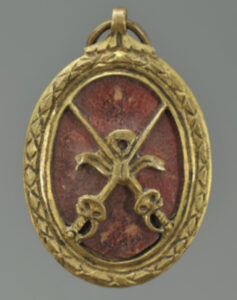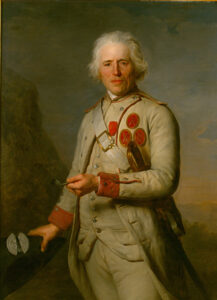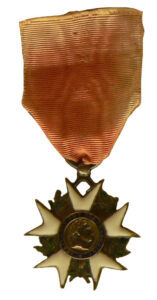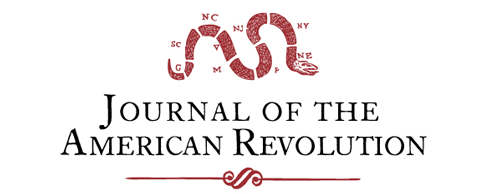Jean Thurel, or Jean Theurel, is one of those very unusual people whose life extended over three centuries. He was born in Orain, Departement de la Côte-d’Or, Bourgogne, France on September 6, 1698 during the reign of Louis XIV. He died at Tours, Indre-et-Loire, France on March 10, 1807 during the reign of Napoleon I. For almost his entire life he was a soldier.
He enlisted in the Régiment de Touraine, today’s 33rd infantry regiment, on September 17, 1716, eleven days after his eighteenth birthday and served there as a fusilier until January 29, 1792—a span of seventy-five years, under Louis XV and Louis XVI.[1] He served in the Charlot Company, Régiment de Touraine and fought in four wars: the War of the Polish Succession, the War of the Austrian Succession, the Seven Years’ War and the American War of Indepenence. Thurel was wounded for the first time in his first campaign, at the Siege of Kehl in 1733. Later, he was shot in the chest with a musket ball during the War of the Polish Succession.
At the battle of Minden in 1759, during the Seven Years War, he received seven sword slashes, including six to his head. He bore the scars for the rest of his life. He lost three brothers killed at the battle of Fontenoy in 1745. One of his sons, a corporal and a veteran in the same company, died on April 12, 1782 during the French campaigns of the American Revolution; he died off the coast of Dominica, West Indies during the naval battle of Dominica (also known as the Battle of the Saintes).
Service in America
Jean Thurel had just turned eighty-three when his regiment came to America in September 1781. He was one of a 2,000-man expeditionary force consisting of the Gatinois, Tourraine and Agenois regiments under the command of the Marquis de Saint Simon Montbleru. These troops landed at Jamestown, Virginia, and marched to Williamsburg to join forces with Lafayette. They served primarily at Yorktown digging and manning the trenches.
The Marquis de Saint Simon also commanded a small body of 200 volunteers drawn from these three regiments to always remain entrenched with the Touraine Regiment. A little before the end of the day on October 6, 1781, one of these volunteers deserted to the enemy and gave them intelligence of the preparations for the opening of the trench. At nightfall, all the workers, supplied with gabions, fascines and tools marched through the woods in silence and arrived at 100 toises (just over 200 yards) from the star fort. Their right was against one of the branches of the muddy creek; their left at the York River. The enemy, informed, kept a very lively and sustained fire on the workers throughout the night, and almost none would have been casualties if Saint Simon had placed an advance picket of grenadiers of the Touraine Regiment with more foresight and less in view of the enemy. There were at least ten killed and several wounded needlessly.
Count de Rochambeau wanted to make only one feint on this flank and decided the real attack would be on the enemy’s left. The feint was entrusted to the Touraine Regiment which was to furnish the workers and the guards.
The trench was opened in the two attacks above and below the York River during the night of the 6th to the 7th. The attack on the right below the river had about 6 to 700 toises of development and four redoubts which supported the right, the left and the center. The enemy concentrated all its attention on the little attack on the left, guaranteeing the one on the right which lost nobody and which found itself sheltered at daylight. The Americans supplied three battalions. The attack on the left above the river, supported by the Touraine Regiment, suffered a little more. A bombardier officer and six or seven Touraine grenadiers were wounded.
The day of the 9th to the 10th, the trench was relieved by the Bourbonnais and Soissonnais regiments under the command of the Viscount de Vioménil. The two battalions of the Touraine Regiment and Saint Simon’s volunteers alternated to relieve the French left. From this location, they thought they saw the enemy unload more cannon for the star fort. This action compelled Count de Rochambeau to have them fire on the vessels to chase them away, despite his intention to have all the batteries play on them together. They substituted two 24-pounders for two 18-pounders to achieve the desired effect. In order to distract the enemy’s attention, the battery on the right of the Americans also began to fire on the British earthworks.
Most of the batteries fired at dawn on the 10th along with the Touraine’s attack battery. Forty mouths of fire, including those of the Americans, soon silenced those of the enemy. The French had three men wounded.
After the British surrender, on November 1 the Gatinois, Touraine and Agenois regiments together with the artillery division which the Count de Grasse had brought from St. Domingue were all boarded on their respective vessels. The admiral then only awaited a favorable wind to set sail for the West Indies. The grand fleet consisted of thirty-six vessels.
West Indies
In February 1782, the British Admiral Hood captured the anchorage of his enemy near St. Christopher. He immediately landed 1,500 men to create a diversion and to attempt to take the land. The Chevalier de Fléchin, second colonel of the Touraine regiment, who found himself within range of the landing, took command of 400 men and marched to the enemy, repulsed them, and covered himself in glory.
Meanwhile, Mr. de Bouillé advanced the siege with vigor and surrounded the British-held fort on Brimstone Hill. A young man of twenty-three named Thion, a soldier of the Touraine regiment, gave uncommon heroic displays of courage during the siege. He carried some bombs in a battery. A cannonball hit his right arm. He took his knife and completely cut off his arm, bandaged himself—a soldier must perform his duty—took the bomb with his left hand and still risked losing it marching to the battery.
Jean Thurel’s Long Career
Thurel was a well-disciplined soldier of the line infantry. He was admonished only once during his entire career, during the siege of Bergen op Zoom, in 1747. The French troops occupied the citadel and the gates were shut, so he scaled the walls of the fortress so as not miss muster.[2]
Another demonstration of his discipline and physical fitness occurred in 1787 when Thurel’s regiment was ordered to march to the coast to embark on French Navy ships. He was given the opportunity to travel in a carriage due to his advanced age, but the eighty-eight-year-old Thurel refused the offer and marched the entire distance on foot, despite the protestations of his comrades and officers. He said that he had never before traveled by carriage and had no intention of doing so at that time.[3]
Honors and Awards
Jean Thurel was a humble, simple, unassuming, well-disciplined man devoted to doing his duties. Unlike some soldiers, he did not seek fame and fortune, glory or promotions. In fact, he constantly refused to accept any promotions and remained a low-ranking fusilier for his entire military career which, including his time in the veteran corps after leaving the Touraine Regiment, lasted ninety years and six months.[4]

Louis XV established the Médaillon Des Deux Épées (Medal of the Two Swords) by royal decree in 1771, hoping to improve re-enlistment rates. This was the first military decoration in France for which an enlisted man could be eligible. It was initially awarded to soldiers who had served in the French Army for twenty-four years, as a reward for their long service. The decree was extended in 1774 to allow sailors of the French Navy to receive the medal.[5] Thurel was awarded two Médaillons Des Deux Épées in 1771, the year the medal was established, in recognition of the two twenty-four-year periods (1716–1740 and 1740–1764) during which he had already served.
The Chevalier de Mirabeau, colonel of the Touraine Regiment (mestre de camp en second du régiment de Touraine) presented the old veteran to the king and to the royal court at the Palace of Versailles on November 8, 1787. King Louis XVI, then thirty-three-years-old, addressed the eighty-eight-year-old Thurel as “father” and asked whether he would prefer to be awarded the Ordre Royal et Militaire de Saint-Louis (Royal and Military Order of Saint Louis) or a third Médaillon Des Deux Épées medal, in recognition of the period from 1764 to 1788.[6] This was a highly unusual request: first, because enlisted men and non-commissioned officers were not normally eligible to receive the Ordre Royal et Militaire de Saint-Louis which was reserved for commissioned officers of the army or the navy; second, because Thurel still had four more months of military service to complete before being eligible for a third medal.[7] Very few men ever completed the forty-eight years of military service required to receive a second medal. Thurel was the only one to have received it thrice.[8]
Thurel opted to receive a third Médaillon Des Deux Épées, on the condition that the king himself attach the medal to his uniform. Louis XVI granted Thurel his wish. The Comte d’Artois (the king’s younger brother) offered Thurel his sword, and the ladies of the court put a carriage at his disposal during his stay in the Paris area.[9]
The Prince of Condé drove him in the carriage and brought him to various houses. Passing rue de Richelieu and observing one of his friends, Thurel asked the prince to stop the carriage. He jumped out and ran into his friend’s arms, and they slowly went arm in arm to a neighboring bar for a drink while the galant tour guide patiently awaited the return of his guest.
Pension
The king also granted Thurel an annual pension of 300 livres, 200 of which would revert to his wife upon his death, and 100 to each of his children upon her death.[10] Some sources say the pension was 600 livres from the king and his brothers and another 300 from the ladies of the court.[11]

The prince of Luxembourg gave Thurel 100 écus on the part of the king and fifty from each of his illustrious brothers. The same year, the Tourangeaux celebrated Bastille Day, July 14, with great pomp. Thurel, now 104, was there and extended his hand to General Liébert’s four-year-old son. Paul Charles François Adrien Henri Dieudonné Thiébault noted that their ages were a century apart. Dignitaries had him sit at their tables. Theaters announced his presence on the billboards.[12]
When veterans’ companies were formed, Thurel asked to be incorporated into the Indre-et-Loire company. He was given a good room and received his pay. General Thiébault, who was in command at Tours at that time, invited him for dinner once a week. The host and his guests were constantly preoccupied with preventing the old man from eating too much. However, when the meal was over, the brave old man sang a little song of the good old days. He preserved a frank gaiety and did not lack a certain spirit of propriety, as evidenced by his answer to a lady asking him if he prayed and often thanked God for having left him so long on earth. Thurel replied with the most cunning smile, “Madame, I have never been in the habit of tiring my friends.”
Legion of Honor
Thiébault sent a report to the First Consul, following which the royal pension of 900 francs was increased to 1,500 francs. Not content with having assured the old soldier’s material well-being, Napoleon included Thurel in one of the first promotions of the newly established Ordre National de la Légion d’Honneur (National Order of the Legion of Honor). Thurel became one of the first recipients of the highest decoration in France on October 26, 1804, at the age of 106. Napoleon I also rewarded him with a pension of 1,200 francs. He was later appointed as the “oldest soldier of Europe.”

Jean Thurel remained healthy in body and spirit throughout his remarkably long life. He died at his home in the city of Tours, Departement d’Indre-et-Loire, Centre, France, after a brief illness, on March 10 1807. He was still enlisted in the army when he died at the age of 107 years, 185 days. Long life ran in his family: his mother lived to 118 years and one of his uncles to 130.[13]
Mr. Joseph Lavallée described him as being “full of loyalty, honour and bravery.”[14] Not only did Jean Thurel live through three different centuries, he served two kings and an emperor and lived under four different governments of France (The Kingdom of France, the Kingdom of the French, the First French Republic and the First French Empire). Napoléon called him, “The Oldest Soldier of Europe.” His entire military career lasted ninety years and six months. All civil and military authorities accompanied the dean of the Legion of Honor and Europe’s oldest soldier to his final resting place.
Further Reading
The only book about Jean Thurel was published in 1881: Delaville le Roulx, Jean Thurel 1699-1807, les portraits d’un fusillier centenaire (Tours: Rouillé -Ladevèze, 1881).
[1] Charles Brockden Brown; Robert Walsh, “Foreign literary and philosophical intelligence,” The American register: or general repository of history, politics and science, Part II for 1807, Vol. II (Philadelphia: C & A. Conrad and Company, 1808), 408. “Le médaillon de vétérance,” Carnet de la Sabretache: revue militaire rétrospective Vol. III (1895), 266.
[2] Ibid., 267.
[3] Brown, “Foreign literary and philosophical intelligence,” 408.
[4] “Le médaillon de vétérance,” 264–73. “n 329, 29 thermidor an IX,” Gazette Nationale ou Le Moniteur Universel (Paris), August 17, 1801, 1355.
[5] Marc Champenois, “Médaillon Des Deux Épées,” Les Décorations, France Phaleristique: Le site des ordres, décorations et médailles officielles de France, www.france-phaleristique.com/medaillon_deux_epees.htm. The first medals were made of fabric and sewn on the uniforms. Later they were made out of metal.
[6] “Le médaillon de vétérance,” 264.
[7] Champenois, “Médaillon Des Deux Épées.” Alexandre Mazas, Théodore Anne, Histoire de l’ordre royal & militaire de Saint Louis, depuis son institution en 1693 jusqu’en 1830 (Paris: Firmin Didot frères, fils et Cie., 1860).
[8] “Le médaillon de vétérance,” 265-266. Champenois, “Médaillon Des Deux Épées.”
[9] “Le médaillon de vétérance,” 266.
[10] Brown, “Foreign literary and philosophical intelligence,” 408.
[11] “Le médaillon de vétérance,” 269.
[12] Ibid.
[13] “n 329, 29 thermidor an IX.”
[14] Annales nécrologiques de la Légion d’honneur (Paris: chez Buisson, 1807).





Recent Articles
Lafayette and the Journey to Yorktown
Facing Washington’s Crossing: The Hessians and the Battle of Trenton
The New Dominion: Virginia’s Bounty Land
Recent Comments
"The New Dominion: Virginia’s..."
Excellent overview of the convoluted system for awarding bounty lands during and...
"Vanishing Ranks: Rawlings’ Rifle..."
Good work here. This being one of the harder units to research,...
"The Declaration of Independence:..."
I don't know whether or not it's true that John Hancock said,...